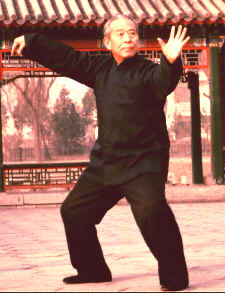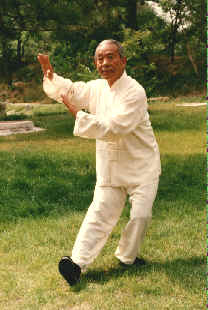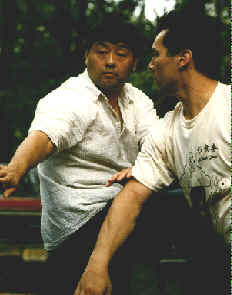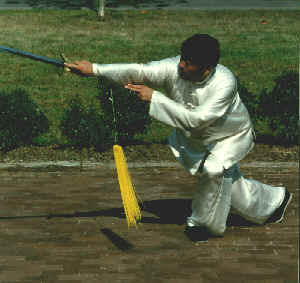Back | Taiji Quan | Bagua Zhang | Xingyi Quan | Tongbei Quan | EIGCT | Basic Gongfu | Qigong | Others
 Single Whip in Shanghai group by Wu Jianquan
|
Taiji Quan is the major
training component in YCGF. Because of its high level principles and detailed techniques,
Taiji Quan can offer a lot of help for practitioners. To understand Taiji Quan is the best
way to understand traditional Chinese martial arts. The style of Taiji Quan practiced in YCGF is Wu style. It started from one of Yang Luchan's best student Quan You. When Yang Luchan taught Taiji Quan in Shen Ji Ying (the Emperor's security camp) in the mid-nineteenth century, he had three excellent students, all of whom were Manchurian: Wan Chun, Ling Shan, and Quan You. The King at the time, Su Wang (King Su), was also one of Master Yang's students and a classmate of Wan Chun, Ling Shan, and Quan You. Because it was forbidden by Manchu custom for commoners to become gongfu (kungfu) brothers to a King, Master Yang arranged for Wan Chun, Ling Shan and Quan You to become disciples of his second son, Yang Banhou. This meant that the three accomplished students could be viewed as members of a lower generation than that of the King. Although Wan Chun, Ling Shan and Quan You became nominal disciples of Yang Banhou, they nevertheless continued to study directly with Master Yang Luchan. Of these three outstanding students, only Quan You passed his skills on to subsequent generations and as a result, only he was responsible for the development of a new and distinctive style. Because Quan You's family changed their family's Manchurian name to the Chinese name of Wu (tone 2) after the Republican Revolution, the style that Quan You developed became known as Wu style. In time, Quan You was recognized and respected as the founder and first generation master of Wu style Taiji Quan. Quan You had many disciples in Beijing. The most famous were Wang Maozhai and Quan You's son Ai Shen, who is more commonly known as Wu Jianquan. In 1928, Wu Jianquan moved to Shanghai in southern China while Wang Maozhai remained in Beijing. These two great Taiji Quan masters came to be known respectively as "Nan Wu Bei Wang" ("South Wu and North Wang"), and Wu style was differentiated into two main groups, one in Beijing and one in Shanghai. Later Wu Jianquan's son, Wu Gongyi, organized a third group in Hong Kong. Today, therefore, there are three distinct groups of Wu style practitioners, and a lot of branches in all over the world.
After Wu Jianquan moved to Shanghai, Master Wang Maozhai continued to lead the Wu style Beijing group and this group became the biggest Taiji Quan group of its time. Master Wang Maozhai also founded the Beijing Tai Miao Taiji Quan Association and had thousands of students, from the Mayor of Beijing to army generals and from business people to martial arts experts. His high level of skill earned him a justifiably excellent reputation. Of Master Wang Maozhai's one hundred disciples, Yang Yuting was the best. When he was only twenty years old, Yang Yuting started to teach Taiji Quan, and during his more than seventy years of teaching, he trained several thousand people. After Wang Maozhai passed away, Yang Yuting became the leader of the Wu style Beijing group. During his long time teaching, Yang Yuting found some aspects of the old training way were not good for practitioners. So from 1930s he started to reform Taiji Quan training. He was the first master who recognized how important it is to make training more systematic. Under Master Wang Maozhai's instruction, Yang Yuting reformed the traditional long form. He standardized all movements in great detail. This way makes it easier and more efficient for people to quickly learn the form correctly. Today this method is applied in most martial arts groups. Today, Master Wang Peisheng, the President of the Beijing Wu Style Taiji Quan Association, is the leader of the Wu style Beijing group. He is one of Master Yang Yuting's first seven disciples. He also received many years of intensive training from his Grandmaster Wang Maozhai. This combination of teachers brought his mastery to a level even higher than that of his most accomplished classmates. Master Wang started to teach at eighteen years of age. He found there are some defects in the old training way. So that he started to reform some thing little by little. From his Wu Style Taiji Quan Thirty-seven Posture Form which is the first short form in China, generally, he set up his own training system called Yin Cheng Gong Fa. Master Wang Peisheng has now taught Taiji Quan for more than sixty years and still works hard and travels far to bring his knowledge of the martial arts and his great wisdom of traditional Chinese culture to people all over the world.
There is a complete Taiji Quan training curriculum in YCGF. The skills listed below are taught in YCGFA-NAH.
Push hands: Weapons:
|
|||
Back | Taiji Quan | Bagua Zhang | Xingyi Quan | Tongbei Quan | EIGCT | Basic Gongfu | Qigong | Others









